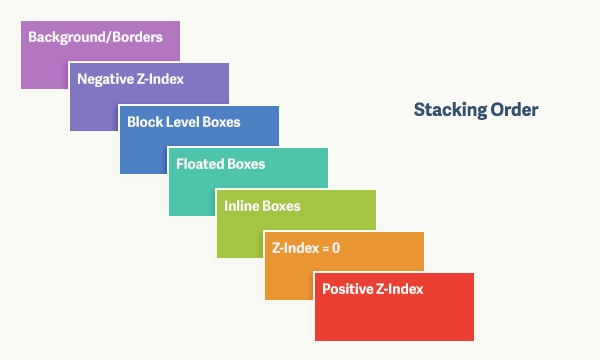1 CSS2.1 中规定的层叠上下文

- Background and borders — of the element forming the stacking context. The lowest level in the stack.
- Negative Z-Index — the stacking contexts of descendants elements with negative z-index.
- Block Level Boxes — in-flow non-inline-level non-positioned descendants.
- Floated Boxes — non-positioned floats
- Inline Boxes — in-flow inline-level non-positioned descendants.
- Z-index: 0 — positioned elements. These form new stacking contexts.
- Positive Z-index — positioned elements. The highest level in the stack.
现在该笔者上场翻译了!在解释上面术语之前,需要阐明两个术语:“定位”指的是 position 为 relative 、absolute 、fixed 的元素,“非定位”则相反。
- 背景和边框:建立层叠上下文元素的背景和边框。层叠中的***级
- 负 Z-index:z-index 为负的后代元素建立的层叠上下文
- 块级盒:文档流内非行内级非定位后代元素
- 浮动盒:非定位浮动元素(笔者注:即排除了 position: relative 的浮动盒)
- 行内盒:文档流内行内级非定位后代元素
- Z-index: 0:定位元素。这些元素建立了新层叠上下文(笔者注:不一定,详见后文)
- 正 Z-index:(z-index 为正的)定位元素。层叠的***等级
引文如上所表。但笔者提醒各位读者一点,“Z-index: 0”级的定位元素不一定就会建立新的层叠上下文。因为:
- CSS2.1:(z-index: auto)The stack level of the generated box in the current stacking context is 0. The box does not establish a new stacking context unless it is the root element.
当定位元素 z-index: auto,生成盒在当前层叠上下文中的层级为 0。但该盒不建立新的层叠上下文,除非是根元素。
规范是这样,但 IE6-7 有个 BUG,定位元素即便 z-index: auto 照样创建层叠上下文。
以上是基于 CSS2.1 的层叠上下文介绍。下面要阐述的是在 CSS3 新环境下,层叠上下文的新变化。
2 CSS3 带来的变化
总的来说变化可以归为两点,我们之后一一探讨:
CSS3 中许多属性会创建局部层叠上下文
tranform 属性改变绝对定位子元素的包含块
2.1 产生新层叠上下文的情况
以下情况会产生新的层叠上下文:
- 根元素(HTML)
- 绝对或相对定位且 z-index 值不为 auto
- 一个伸缩项目 Flex Item,且 z-index 值不为 auto,即父元素 display: flex|inline-flex
- 元素的 opacity 属性值小于 1
- 元素的 transform 属性值不为 none
- 元素的 mix-blend-mode 属性值不为 normal
- 元素的 filter 属性值不为 normal
- 元素的 isolation 属性值为 isolate
- position: fixed
- will-change 中指定了上述任意属性,即便你没有直接定义这些属性
- 元素的 -webkit-overflow-scrolling 属性值为 touch
以上列表译自:
https://developer.mozilla.org/en-US/docs/Web/CSS/CSS_Positioning/Understanding_z_index/The_stacking_context,提醒广大读者,别看中文版,因为中文版并非实时跟进更新的,且翻译不太准确
2.2 提升层叠上下文中的层级
以上元素建立新层叠上下文的同时,也会提升元素自身所在层叠上下文中的层级。
我们以 opacity 为例。来看下 CSS3 规范中的话:
- If an element with opacity less than 1 is not positioned, implementations must paint the layer it creates, within its parent stacking context, at the same stacking order that would be used if it were a positioned element with ‘z-index: 0’ and ‘opacity: 1’. If an element with opacity less than 1 is positioned, the ‘z-index’ property applies as described in [CSS21], except that ‘auto’ is treated as ‘0’ since a new stacking context is always created.
如果元素 opacity 小于 1 且未定位,则必须在其父层叠上下文中,按其在定位了的、z-index: 0 且 opacity: 1 的情况中的层叠顺序绘制。如果 opacity 小于 1 且已定位,z-index 属性按 CSS2.1 应用,但 auto 要视为 0,因为新的层叠上下文总是创建了的。
如下案例:
- div {
- width: 100px;
- height: 100px;
- }
- #box1 {
- position: absolute;
- background: red;
- top: 40px;
- left: 40px;
- }
- #box2 {
- background: blue;
- }
- <body>
- <div id="box1"></div>
- <div id="box2"></div>
- <body>
以上 CSS 和 HTML 片段中,由于 box1 是绝对定位(层级为“Z-index: 0”级),而 box2 是文档流内块级盒(层级为“块级盒”级),因此 box1 会层叠在 box2 之上。下面添加如下 CSS 规则:
- #box2 {
- opacity: .5;
- }
这时候, box2 则会层叠在 box1 之上了。因为 box2 的 opacity 为 0.5(小于 1),故视其为“Z-index: 0”级,也就和 box1 同级了。同级情况下,按照二者在源代码中的顺序,居后的 box2 又重新占领高地了。
读者可以取下面规则之任意一条实验,都能达到同样效果:
- #box2 {
- transform: scale(1);
- mix-blend-mode: difference;
- isolation: isolate;
- -webkit-filter: blur(5px);
- }
2.3 transform 改变绝对定位子元素包含块
transform 除了建立新的局部层叠上下文外,还会干一件事:改变绝对定位子元素的包含块。须注意的是,固定定位也是绝对定位的一种。
什么是包含块?有时候一些盒子根据矩形盒计算自身定位和大小,此矩形盒即包含块。更多详情请阅读视觉格式化模型详述。
固定定位元素
固定定位元素的包含块由视口创建(如果读者了解视觉格式化模型详述的信息,也就知道这一点:在计算其“静态位置”的时候,则以初始化包含块作为其计算包含块)。现在我们看以下源代码:
- div {
- width: 100px;
- height: 100px;
- }
- #fixed {
- position: fixed;
- width: 100%;
- height: 100%;
- top: 0;
- left: 0;
- background: blue;
- }
- #transform {
- background: red;
- padding: 20px;
- }
- <body>
- <div id="transform">
- <div id="fixed"></div>
- </div>
- </body>
这个时候,以视口为包含块进行定位和大小计算, fixed 将会铺满整个屏幕。
但现在,我们加上如下规则:
- #transform {
- transform: scale(1);
- }
此时,fixed 的包含块不再是视口,而是 transform 的内边距盒的边缘盒了。故此时 fixed 的宽高均为 140px。
绝对定位元素
我们举一个例子:
- #relative {
- position: relative;
- width: 100px;
- height: 100px;
- background: green;
- }
- #absolute {
- position: absolute;
- width: 100%;
- height: 100%;
- top: 0;
- left: 0;
- background: blue;
- }
- #transform {
- background: red;
- width: 50px;
- height: 50px;
- }
- <div id="relative">
- <div id="transform">
- <div id="absolute"></div>
- </div>
- </div>
此时 absolute 的包含块为 relative 的内边距盒的边缘盒。由此 absolute 的宽高均为 100px。然后我们添加如下规则:
- #transform {
- transform: scale(1);
- }
由于 transform 创建了局部层叠上下文,absolute 的包含块不再是 relative 而是 transform 了,根据这一新的包含块,得新宽和高为 50px。


































